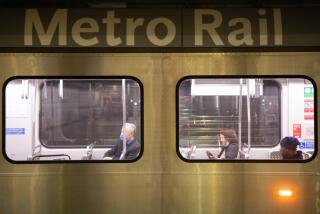Fear and questions hitch a ride on the Red Line
- Share via
I intended to ride the Red Line subway through Hollywood this week, as if that might help me understand the bizarre scene that unfolded in front of dozens of horrified riders last weekend:
A middle-age man, wildly swinging a chain; a younger man fending him off with a skateboard, then stabbing him with a knife.
And captive commuters forced to choose sides: tend to a bloodied, dying man, or mollify his frantic attacker with getaway advice.
It was the first violent death on the subway since the line opened 18 years ago. The suspect took off minutes later, when the train pulled into the underground station at the next stop, Hollywood and Vine.
Sheriff’s deputies have arrested a transient in the case. They say they used surveillance photos and witnesses’ accounts to track Gene Sim to Buena Park.
According to riders — including a Times reporter heading home from work on the subway that night — the stabber frantically pleaded with passengers to back up his story of self-defense.
Then two young women suggested that he change out of his bloody clothes; put on the clean shirt he had in his backpack. He did, and when the subway doors opened, he melted into the crowd and headed off unnoticed.
That was the detail that shook me up, beyond the tragedy of the killing. The women didn’t simply agree to back up his account to police. They seemed to encourage a knife-wielding killer to flee.
Did they see him as urban avenger, fighting off a crazy subway menace? Were they trying to calm a frantic killer, so he didn’t use his knife again?
Or did they just want him to disappear, as if that might erase what they had just seen?
::
I’ve been turning it around in my head all week. Was this Bernhard Goetz or Kitty Genovese?
Goetz was the New York City “subway vigilante” who in 1984 shot four young men who were trying to rob him. Genovese was a young woman stabbed to death in 1964 while dozens of her neighbors reportedly looked on and did nothing.
Goetz became a symbol of street justice; Genovese a reflection of bystander apathy.
The choice here isn’t that simple, Todd Martens told me. Martens is the Times reporter who was riding the Red Line that night, just a few feet from where the fight broke out.
He understands why I, and so many others, have fixated on the choice those women passengers made. The debate has raged among Times readers on our online comment boards.
Some say the women should be considered accessories to homicide. Others say they may have saved riders’ lives by calming down a man with a knife.
We’re trying to find some message, some way to impose rational order on the frighteningly irrational scene.
Martens told me we may be relying too much on that moment as a compass to give this meaning.
“The optimist in me wants to believe that they were simply trying to keep the assailant from shifting moods,” Martens wrote in a chilling blogpost. “The pessimist in me is frightened that [they] viewed him as a lesser evil than the police....”
His account renders clearly the shock, panic and fear that cascaded through the subway car — upending a commuter culture that relies on nobody seeing nothing.
Metro spokesman Marc Littman said the rarity of violence on the subway cars is what makes this so unsettling.
That, and the fact that you’re underground — “30 to 60 feet, or more in some cases” — trapped inside a tunnel with a random cast of characters, some of them “unusual.”
“I’ve been on trains and buses where people are talking to themselves,” said Littman, who has used public transit all his life. “I’ve seen a guy with a parrot on his shoulder; people singing and playing guitar, hawking batteries and transit passes and all sort of contraband.
“People generally just ignore it.”
::
With that in mind, I intended to ride the Red Line from my downtown office on Thursday to Hollywood and Vine, where the stabbing scene played out. But an assignment in Koreatown ran past 8 that night, so I headed instead for the nearest station, at Wilshire and Vermont.
I parked on the street and followed a middle-age woman carrying a Trader Joe’s bag to the ticket machine. But I stalled at the turnstile apparatus; there was no slot for my $5 all-day pass.
“Just walk through, just walk through,” a young man in baggy jeans and do-rag yelled from the escalator, homing in on my distress. I pushed through, waved my thanks — and realized that I might have been wary of him if we’d passed on the sidewalk near the transit plaza.
I tried to keep subway etiquette in mind: don’t look at anyone, don’t make small talk. I didn’t realize that I was on the wrong train until the operator announced “Wiltern Theatre. Final stop.”
I had boarded the Purple Line by mistake. I had to break the no-talk rule and ask. A young man, with bushy Afro and baggy shorts, directed me back toward Union Station and told me to exit where I began. He traced the route on a map with his finger for me. “Just stand under the sign,” he said.
My comrades on the short ride back didn’t seem that unusual. Guys in work clothes with sweat-stained backpacks, a woman holding a sleeping toddler and a couple huddled around a pair of suitcases, with LAX tags attached.
In the seat next to me a young woman with a Fullerton College bookstore bag was trying not to nod off. A guy with a briefcase was working the aisle, politely peddling “nice hair bands that would fit your style,” he said. A skinny blond with an ugly cough was sitting too close, a few rows back. And stretched out on two seats across the aisle was a teenage boy with a skateboard and backpack.
I found myself watching his hands, reflexively thinking back to that night on the Red Line a week ago.
Then we both stood up, at Wilshire and Vermont. And when the doors opened, he smiled, stood aside, and I walked past.
More to Read
Sign up for Essential California
The most important California stories and recommendations in your inbox every morning.
You may occasionally receive promotional content from the Los Angeles Times.













